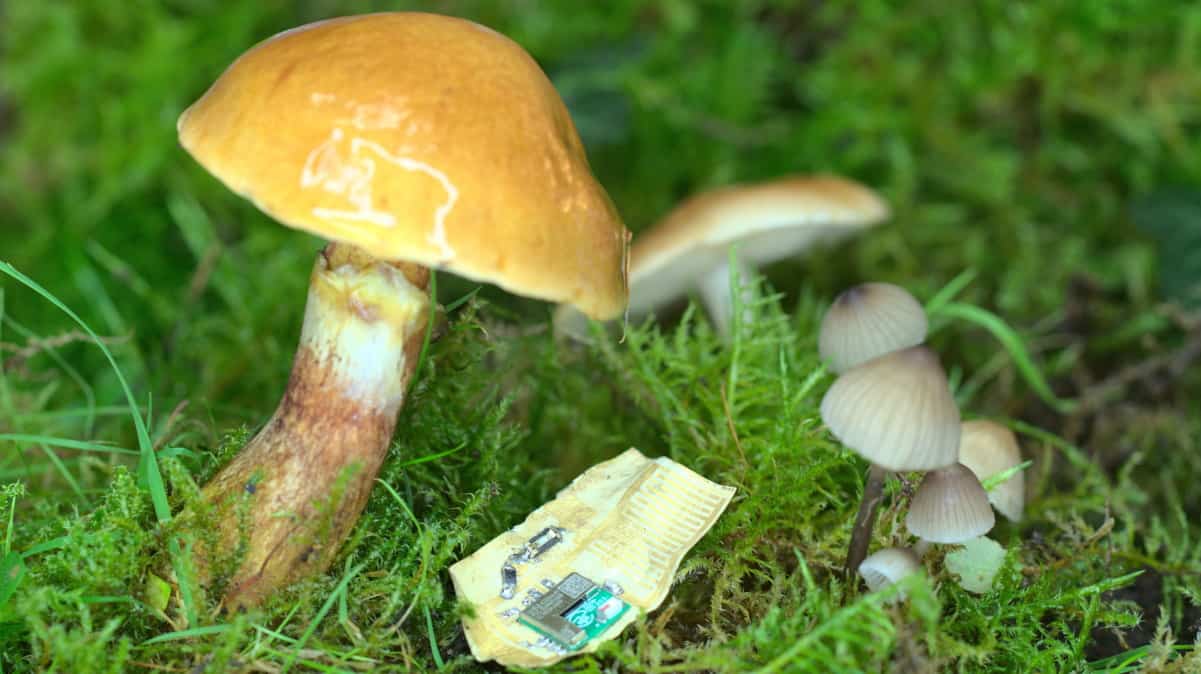
Fungal mycelium skins can be used as substrates for electronic devices, physicists and materials scientists in Austria have shown. The team used the thin skins to create autonomous sensing devices consisting of mycelium batteries, a humidity and proximity sensor, and a Bluetooth communication module. As well as providing a flexible surface for electrical circuits to be patterned on, the skins are biodegradable and could help cut electronic waste.
The researchers produced the mycelium skins from the fungus Ganoderma lucidum, which grows on dead hardwood in mild temperate climates. To create electronic circuits, they used physical vapour deposition to place a thin layer of copper and gold on the skin. Metal was then removed from this surface layer via laser ablation, leaving behind conducting paths. The researchers named this novel approach to creating flexible and biodegradable electronics “MycelioTronics”, describing their work in Science Advances.
The vast number of devices produced nowadays, along with their decreasing lifetimes, leads to enormous amounts of electronic waste, and the volumes are rising rapidly. According to the Global E-Waste Monitor 2020, a record 53.6 million tonnes of such e-waste was discarded in 2019 – a figure that’s projected to increase to 74.7 million tonnes by 2030.
There’s also an increasing focus on the development of flexible electronics, for autonomous sensors for health monitoring, for example, that have lifespans of just days or weeks. According to Martin Kaltenbrunner, a physicist at the Johannes Kepler University, for these types of electronics, biodegradable components would be very advantageous.
“The one thing that is really difficult to recycle is the flexible or printed circuit board… they’re just too cheap and too difficult to separate into their individual parts,” Kaltenbrunner explains. Scientists have been looking at replacing polymer-based circuit boards in flexible devices with paper, but Kaltenbrunner says that this is not sustainable. Paper production is too water and energy intensive.
Paper-like skins
While working on mushroom-based materials for building insulation, Kaltenbrunner and his colleagues noticed that the fungi were producing a dense and compact skin of mycelium, which is a network of fungal threads. These skins looked like paper and the scientists wondered if they could be used for flexible circuit boards.
The team grew mycelium skins by covering moist beech wood shavings inoculated with Ganoderma lucidum with a polyethylene separator grid and storing them at 25°C. After sufficient fungal growth, the separator was ripped off the substrate and the mycelium skin was carefully peeled off the separator. The wet mycelium was then dried and compressed to produce the final skins.

After deposition and laser ablation of the metal layer, the researchers tested the resulting mycelium circuit boards. They found that that they had high conductivity and thermal stability, and were able to withstand around 2000 bending cycles before the metal film started to crack and electrical resistance increased. The skins could also be folded several times with only moderate increases in resistance.
Next the researchers created a flat, 2 cm2 mycelium battery, using a mycelium skin soaked in a highly ion-conducting electrolyte solution (ammonium chloride and zinc chloride) as the separator, and two mycelium skins as the outer casing. This structure results in a high percentage of the battery being biodegradable, they claim.
To further demonstrate their concept, the team created an electronic device consisting of a mycelium battery, a Bluetooth data communication module and an impedance sensor soldered onto a mycelium circuit board. Tests showed that this sensor device was able to detect an approaching finger and changes in humidity in a climate chamber.

Carbon-based inks make first fully recyclable transistors
Once they had finished with the circuits, the researchers found they could remove the reusable surface-mounted components using a heat gun or solder iron. This left the mycelium circuit board, which disintegrated in a compost heap. Within 11 days it had lost 93% of its dry mass and after this point any remains were indistinguishable from the soil.
“You can put it in your household compost,” Kaltenbrunner tells Physics World. He explains that this is the advantage of their fungal materials over biodegradable plastics that require specific conditions to breakdown, “mycelium is literally everywhere in our natural environment” and the skins are a completely natural product.
